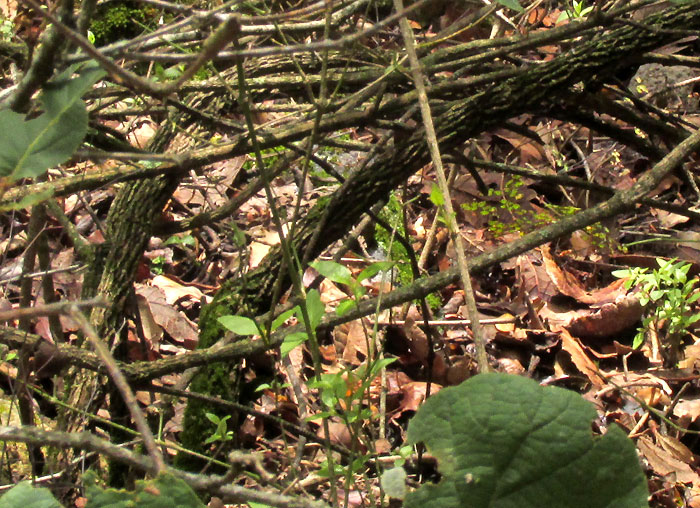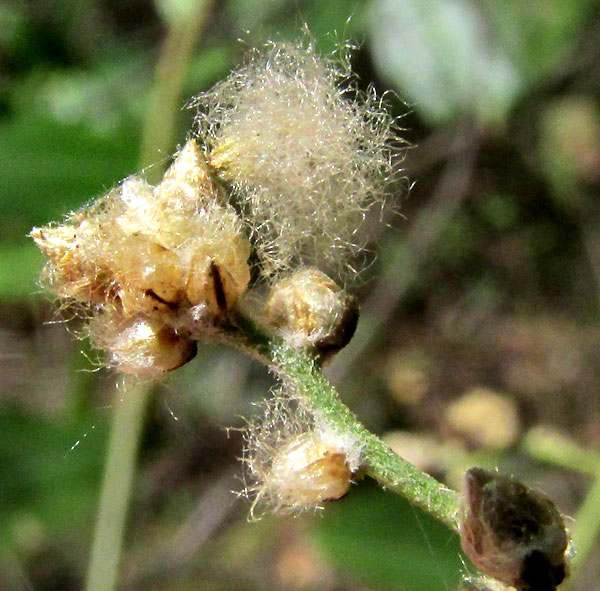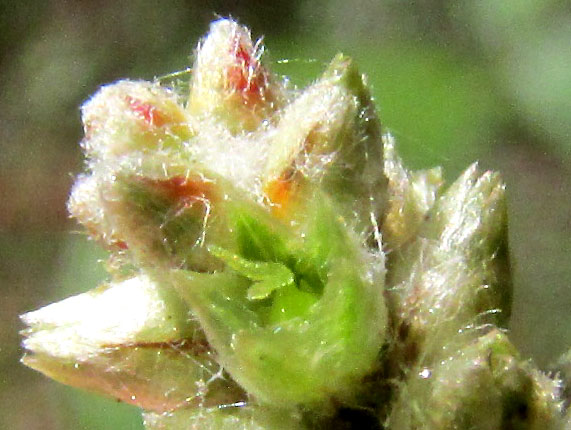Excerpts from Jim Conrad's
Naturalist Newsletter
entry from field notes dated July 3, 2022, taken on the eastern lower slope of Cerro de la Cruz, at an elevation of ~2700m (~8850 ft), just south of the community of El Pinar, Amealco de Bonfil, Querétaro, MÉXICO, (~N20.17°, ~W100.17°)
IRESINE LATIFOLIA

On the lower eastern slope of Cerro de la Cruz where the valley floor begins and the oak forest transitions to an open area of clumpgrass with scrubby vegetation and bare rock, on a steep slope as the trail passed through a thicket of young trees and bushes, the above curious collection of tiny, fuzzy items caught my attention. It was a diffuse inflorescence of tiny flowers dispersed in small, compact clusters. Note that the inflorescence rachis branching from the woody stem is green and seemingly hairless. Later this will be an important field mark to consider. Also, the green leaves in the background appear to be of this species, and on their stems they arise opposite one another.
With trees on the opposite slope in the background, below you can see several inflorescences like the above, all arising from the ends of long, slender, arching, woody stems.

The larger stems, here at the end of a prolonged dry season, are leafless. The plant grew so deeply inside a thicket that I couldn't get to it, but using the telephoto lens managed to get the picture shown below, which shows simple leaves emerging from young stems. If the leafy stems are from our scraggly shrub, as they seem to be, they're typical of the species I think this might be.

Normally flowers best tell us a plant's identity, however, and here's a fairly fuzzy head of them:

The above shows tight clusters of short spikes of flower buds. Each spike has below it a dark-ribbed, triangular bract (scale-like modified leaf), and within each spike every immature flower is subtended by a smaller bract. Each flower bract bears at its base long, cottony hairs, and those long hairs are a distinctive feature of this species. Among our bush's many clusters of flowering spike, only one spike was mature enough to present a single open flower:

That tiny, green flower with five tepals -- tepals being the term when sepals and petals are indistinguishable from one another another -- is home to a healthy, green, oval ovary topped by a short style with two stigmas. On the far side of the flower, peaking over the ovary's shoulders, the heads of two pale, staminodes can be seen, staminodes being reduced, sterile stamens. In other words, this is a female flower. Also notice that the tepals are somewhat transparent, or scarious, along their margins, plus they are separate from one another, not joined at their bases. The cobwebby airs arise from the backs of tepals and bracts.
Tiny flowers with scarious-margined tepals, and each flower with a bract below it, and leaf margins with no teeth, lobes or scallops, generally means the Amaranth Family, the Amaranthaceae. In our area, if you have something in the Amaranth Family with leaves on woody stems arising opposite one another, flowers in compact clusters diffusely arrayed at the ends of branches, and flower tepals not joined at their bases, you have the genus Iresine. And if you have an Iresine with a woody stem tending to lie down, and with tepal backs covered with cobwebby hairs up tod tmm long, you have IRESINE LATIFOLIA.
Iresine latifolia has no English name. It's distributed from northern Mexico south into Columbia in South America, favoring tropical deciduous scrub.
The online Atlas de las Plantas de la Medicina Tradicional Mexicana, which uses an earlier binomial, Iresine calea, and in Spanish calls it pelusa, meaning "fluffy," cites a long history of traditional medical uses for our plant. In the 1500s the Florentine Codex reported that the Aztecs made plasters of its leaves to reduce nipple swelling, aid in digestion, and as a refreshing diuretic. In the 1800s the Mexican Society of Natural History mentioned its use against malaria, to induce sweating, as a diuretic, and against typhoid fever.
In fact, the Atlas quotes studies finding that when 0.1ml of extract of our bush is administered per 100g of rat, the rats do indeed urinate significantly more, supporting the traditional use of the plant as a diuretic.